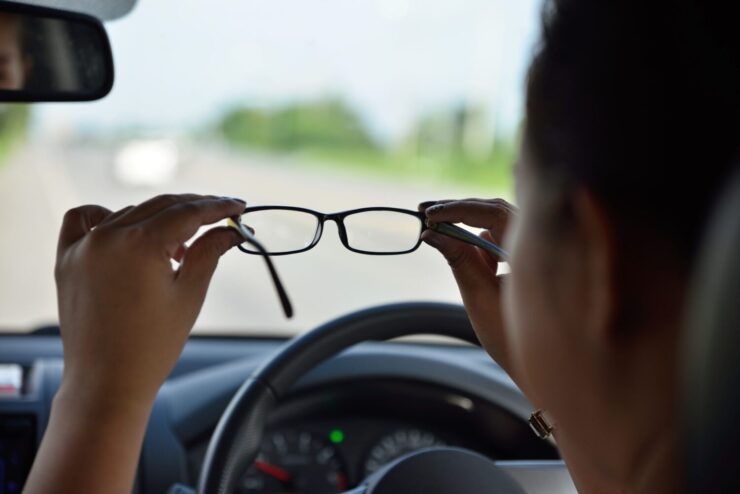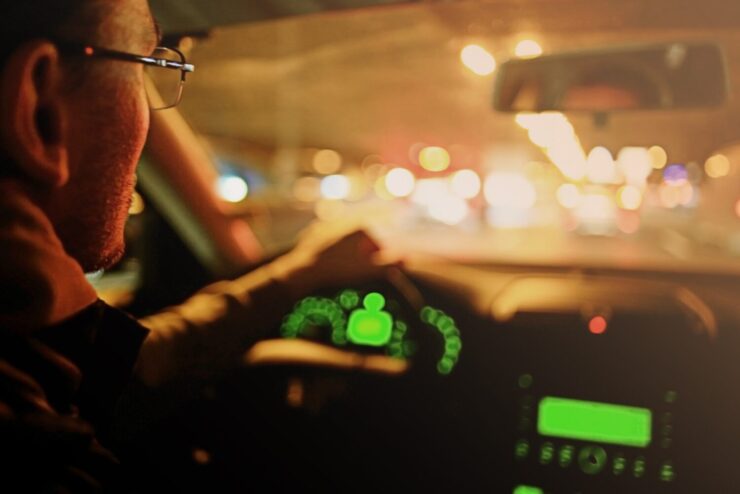At some point, every driver will experience it, likely in their 40s or 50s.
They get into the car for the first night after the sun has set and realize they’re driving at a much more challenging condition than before. Not impossible. Not ten times worse.
Just enough that it feels notably more challenging than before. Headlights are brighter.
Street signs are harder to read. That confidence from the daytime operating a vehicle slowly dissipates.
It’s not a figment of imagination either, nor is it a sign that they’ve lost their driving capabilities. It’s just the change that occurs to the ocular system with age, the eye, and it can often be most diagnosed by what’s most prominent at night.
With greater education about what’s truly going on, it becomes more accessible to avoid channeling fear and relying on practical adjustments to sidestep avoidance.
What’s Really Happening in Aging Eyes

The eye is a surprisingly complicated organ, so it’s no surprise that the various stages of deterioration that occur with age happen through different parts of eye health simultaneously.
Consider first the pupil, which regulates how much light enters the eye. Post-40, pupils don’t dilate as big as they used to; where a pupil may grow 7mm wide in the dark at 30, by 60 years old, it might be barely 5mm wide.
Therefore, almost 40% less light is hitting the retina, causing dimmer circumstances.
The lens is also crucial. Throughout one’s life, it gradually becomes less transparent as it grows slightly yellowed, think of a windshield that hasn’t been cleaned for decades. While this doesn’t matter during incredibly bright scenarios with plenty of excess light to share with others, at night, it’s critical to maintain clarity.
When it comes to yellow tints instead of whites, if someone can’t discern between blue and purple or yellow and brown at night, the yellow tint affects color perception.
Denser lenses matter too; a gradual process is expected throughout aging and minor from an individual perspective. However, when light runs into a denser medium, more scattering occurs.
When someone is receiving oncoming traffic’s headlights through that denser lens, the light scatters instead of going through; halos and starbursts occur around any light source.
So when it’s harder for older drivers to see headlights, it’s not that they’re that much brighter (even though LED lights do them no favors), it’s that aging eyes perceive them as such.
Why Regular Glasses Don’t Always Work

Most people assume that if their prescriptions are correct, they’ll be good to go, after all, eyesight isn’t sound; those with horrible vision do not struggle during the day because they have no desire but do complain about nighttime vision due to adjustment issues, but this isn’t how it always works.
Eye exams generally occur in well-lit situations with proper findings per maintained atmosphere; therefore, adjustments made for bright or dim scenarios do not extend to effective in-between strategies for night driving.
For example, glare plays a significant role. Prescription lenses can make glare worse if improper coatings are used.
The reflective properties bounce through lens materials and create surface reflections; anti-reflective coatings, help, but are not all made the same (lesser valued coatings get dingy over time).
Some find that prescription night driving glasses specifically marketed for night driving make a note-worthy change from their everyday eyewear. They’re not magical; they’re merely modifiable for those specific situations where normal glasses fail entirely.
Contrast sensitivity also plays a role, a major contributing factor to the distinction between objects and their background when their brightness isn’t very dissimilar.
Standard prescriptions focus on visual acuity (how small letters someone can read) without factoring modifications necessarily appropriate for contrast, but at night, everything becomes grayscale or dimmer colors.
The Headlight Problem No One Talks About
Modern technology has changed the landscape of vehicle lights, and not for the betterment of the traveling community.
LED and HID headlights are much brighter and whiter than halogen bulbs, while they can illuminate darkness better for that driver; they illuminate brightness no matter where it’s directed with equal aggression.
And it’s not just brightness that’s a problem, it’s also color temperature; new headlights boast blue-whiteness which scatters more through space and eye than warmer yellows.
Blue light creates more glare than yellow from natural sources and aging eyes already struggle with increased light scatter through them, let alone new-age headlights filled with blue.
And poorly adjusted headlights are more common than drivers realize, when they’re not adjusted properly (just like drivers need to replace older headlights from wear and tear), they shine into people’s eyes instead of downward on the road.
When To Worry

Not all night problems exist due to regulated time of day shifts; instead, many eye conditions may cause or worsen nighttime troubles, and some are treatable.
Cataracts are the first on the list, as everyone develops some form of cataract initiation over time as they age, some develop worse, faster than others.
Cataracts disperse light; decrease contrast; nighttime is the worst for visibility due to their cloudy presence. Fortunately, cataract surgery is reliable and routine.
Astigmatism also causes problems, even mild ones, as those with astigmatism have an irregularly shaped cornea which bends light unevenly; it produces those classic starbursts around lights while many experience slight astigmatism during the day but legitimate issues at night (corrective lenses can help).
People don’t think of dry eyes as relevant to vision patterns at night, but dry eyes when they’re tired become inclined to have more tear films on the surface, less smooth means less of a good optical surface through which light moves.
In addition, diabetes affects small retinal vessels that create diabetic retinopathy; nighttime vision is no good for those experiencing increased glare sensitivity from a driver perspective. Anyone who has diabetes should assess what’s going on sooner rather than later.
Practical Solutions That Make A Difference
Windshields should be clean, drivers rarely realize how dirt or grime can settle on windows, and while they might not be visible during the day, nighttime can scatter them and make it much worse for glares to emerge; cleaning on a regular basis (inside and outside) makes a measurable difference even when it doesn’t seem obvious.
Using proper glass cleaners instead of just water gets rid of oily residue.
In addition, dashboard brightness matters; while most cars come equipped with overly bright digital panels during the day to easily discern something on the move, a dark car at night with bright dashboards makes pupils constrict, it’s better to keep them open and let more light through for optimal road conditions at night.
Drivers should slow down without being hazardous; while going twenty miles per hour under the speed limit may become its own danger (think highway hazards), having extra following distance and being less aggressive with passing/getting into other lanes makes sense as one second becomes valuable extra time for visual processing.
For long drives at night especially, breaks are important, eyes get tired just like any other body part, and at nighttime when older adults don’t necessarily blink as much because they’re focusing on other cautionary elements (time constraints or wondering which one was just flicked by another car), they need more breaks every hour or so to rest and refocus for an ultimately longer journey.
The Bottom Line About Aging Eyes And Night Vision

Night driving doesn’t have to come to an end during senior status; it just means adjustment, but from an ocular perspective that’s changed over time due to biology, recognizing what’s transformed helps avoid anxiety over complications that aren’t complicated, they’re just what happens over time.
For most people, glass modifications combined with vehicle solutions make sense to mitigate against responsibility failures.
Current prescriptions/nights lenses improved; vehicle solutions regulated; adjusted caution for safe driving at night attributes toward greater calmness when they’ve always been anxious.
People who fail are those who push through without adjusting anything merely out of traditional comfort, those who do well make adjustments without relying on nighttime driving as a measure of failure.
Aging happens; it’s how people adjust that’s effective instead of stubbornness against change.

